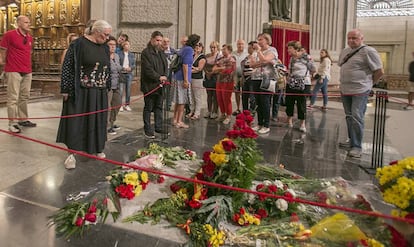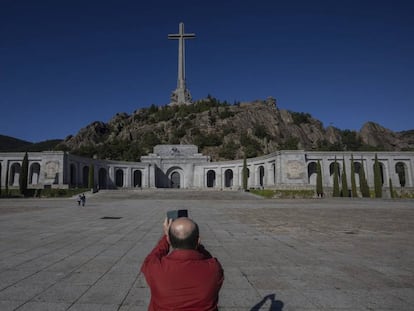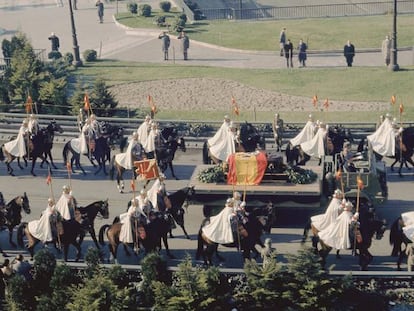The last Sundays with Franco
Thousands of people are traveling to the Valley of the Fallen to take a selfie at the Spanish dictator’s tomb before his body is transferred elsewhere


A tall blonde woman hurries toward the booth located at the entrance of the Valley of the Fallen. “They’re really pulling out all the stops!” she says, pointing at a line of vehicles waiting outside the gates of this controversial Spanish Civil War monument, which is also the resting place of the late dictator Francisco Franco.
The new influx of visitors has been triggered by a recent Supreme Court decision to allow the exhumation of Franco’s remains and their transfer to the Madrid cemetery of El Pardo-Mingorrubio. The move has been a signature project of caretaker Prime Minister Pedro Sánchez, of the Socialist Party (PSOE), but it had been held up by legal challenges filed by Franco’s relatives.
The imminent exhumation has brought mayhem to this place. First there’s the stream of nostalgics: these days, Franco’s grave is as much of an attraction as Jim Morrison’s, save that Morrison’s is packed with whisky bottles and cigarettes, whereas Franco’s is covered with red and yellow roses, carnations and daisies. And it is also surrounded by the bodies of hundreds of his victims who were also buried here.
There is a lot of security around: there are new checkpoints on the road leading to the Roman Catholic underground basilica located inside the site, and a greater presence of law enforcement officers. Last weekend there were more than 6,000 visitors to the site, according to the news agency Europa Press.
These days, Franco’s grave is as full of people as Jim Morrison’s
A visit to the Valley of the Fallen is such an outlandish experience that even their website offers the following piece of advice from William, who was the abbot of the monastery of Saint Teodorico in medieval times: “You must be liked by God, you must understand Him, penetrate Him, enjoy Him.”
Nothing around here really makes a lot of sense. This is a monument that is being maintained by a democracy to honor the memory of the dictator who crushed it in the first place. In 2018, five separate fires broke out in the forest surrounding the site, started purposely to reduce the whole place to ashes. They were quickly put out, and the perpetrators were never found.
The area immediately surrounding Franco’s grave is abuzz with activity, and the security guard is unable to handle it all by herself. “You’re going to get me fired! Please don’t take any photographs, please don’t!” But people are taking pictures everywhere, from all angles. There are families taking selfies, men looking emotional, smiling young boys. A woman kisses a little gold medal hanging around her neck.
There is now a line of people standing around the grave. When it’s someone’s turn, they squat or kneel in front of the tombstone and smile. One person gives a thumbs-up, as if he’d just been signed by his favorite team. Another man bursts into tears and makes the sign of the cross in front of another grave, this one containing the remains of José Antonio Primo de Rivera, the founder of the Spanish fascist party Falange.

They are not all Franco nostalgics. There are a lot of different people here, including many families with children. There are tourists and people who came out of curiosity. A student named Roberto says he had his picture taken in front of Franco’s grave because “since we’re already here, I might as well.”
“Look,” says María del Carmen, a retiree who came here with her husband. “If those who went through [the Civil War] were able to forgive, why not now? [Franco’s body] doesn’t bother anyone here. And this is part of the history of Spain, whether one likes it or not. The body should not be moved, nor should history be stirred up like that.”
Several other people standing in line have an identical message to deliver. Others, like Fernando, who has come here all the way from Galicia, are more categorical: “He’s not moving from here, not now nor ever.” A woman who has just had her picture taken near the grave sighs: “How I wish I could have heard him speak!”
The government wants the transfer to take place before the repeat general election of November 10. If that happens, this year there will be no traditional tribute to Franco on November 20, the anniversary of his death, at least not at the Valley of the Fallen.
This is a monument that is being maintained by a democracy to honor the memory of the dictator who crushed it in the first place
Standing on the esplanade that affords spectacular views of the Guadarrama mountains, a woman complains, as though the landscape were going to be permanently deleted: “They really want to take all this away from us?”
Also on Sunday, around 50 kilometers from here, the far-right party Vox held a rally during which its leader, Santiago Abascal, attacked the government’s plans to transfer Franco’s body. “They don’t respect the dead or their families,” he told a crowd of thousands. “We love Spain and we love reconciliation.”
The scene at the Valley of the Fallen this past Sunday was the best example of what the far right sees as “not reopening the wounds of the past”: leaving two fascist leaders’ tombs out in the open where people can honor them, while anonymous bodies lie scattered all around. As the author Fernando Fernán Gómez once wrote, their so-called reconciliation is not so much about peace as it is about the prolongation of victory.
English version by Susana Urra.
Tu suscripción se está usando en otro dispositivo
¿Quieres añadir otro usuario a tu suscripción?
Si continúas leyendo en este dispositivo, no se podrá leer en el otro.
FlechaTu suscripción se está usando en otro dispositivo y solo puedes acceder a EL PAÍS desde un dispositivo a la vez.
Si quieres compartir tu cuenta, cambia tu suscripción a la modalidad Premium, así podrás añadir otro usuario. Cada uno accederá con su propia cuenta de email, lo que os permitirá personalizar vuestra experiencia en EL PAÍS.
¿Tienes una suscripción de empresa? Accede aquí para contratar más cuentas.
En el caso de no saber quién está usando tu cuenta, te recomendamos cambiar tu contraseña aquí.
Si decides continuar compartiendo tu cuenta, este mensaje se mostrará en tu dispositivo y en el de la otra persona que está usando tu cuenta de forma indefinida, afectando a tu experiencia de lectura. Puedes consultar aquí los términos y condiciones de la suscripción digital.
More information
Archived In
Últimas noticias
Welcome to the post-religion era: The idea of Christianity as the absolute truth has become obsolete
‘I thought you would like it’: The risky sexual practice popularized by TV shows and TikTok
The digitalization of tourism: ‘They promise experiences and gave us the worst possible one’
Mexican peso defies uncertainty with forecasts of a new period of stability in 2026
Most viewed
- Sinaloa Cartel war is taking its toll on Los Chapitos
- Oona Chaplin: ‘I told James Cameron that I was living in a treehouse and starting a permaculture project with a friend’
- Reinhard Genzel, Nobel laureate in physics: ‘One-minute videos will never give you the truth’
- Why the price of coffee has skyrocketed: from Brazilian plantations to specialty coffee houses
- Silver prices are going crazy: This is what’s fueling the rally










































